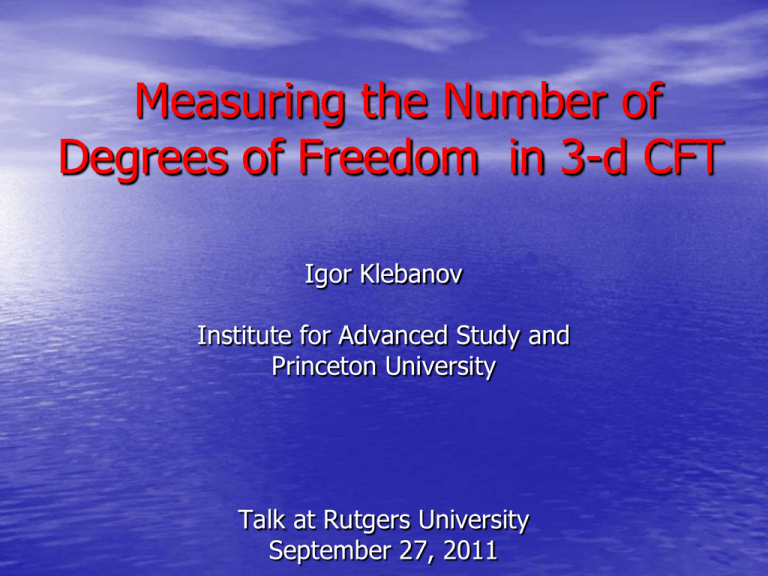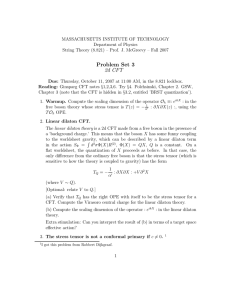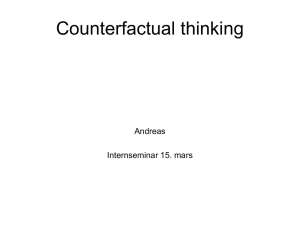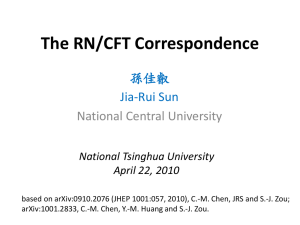Slide 1 - Rutgers University
advertisement

Measuring the Number of Degrees of Freedom in 3-d CFT Igor Klebanov Institute for Advanced Study and Princeton University Talk at Rutgers University September 27, 2011 The talk is based mainly on the papers • C. Herzog, I.K., S. Pufu, T. Tesileanu, Multi-Matrix Models and Tri-Sasaki Einstein Spaces, 1011.5487. • D. Jafferis, I.K., S. Pufu, B. Safdi, Towards the F-Theorem: N=2 Field Theories on the Three-Sphere, 1103.1181. • I.K., S. Pufu, B. Safdi, F-Theorem without Supersymmetry, 1105.4598. • A deep problem in QFT is how to define a `good’ measure of the number of degrees of freedom which decreases along RG flows and is stationary at fixed points. • In two dimensions this problem was beautifully solved by Alexander Zamolodchikov who, using two-point functions of the stress-energy tensor, found the c-function which satisfies these properties. • At RG fixed points the c-function coincides with the Virasoro central charge, which is also the Weyl anomaly. It also determines the thermal free energy. • For d>2 it also seems physically reasonable to use the coefficient cT of the thermal free energy as the measure of the number of degrees of freedom: • It can be extracted from the Euclidean path integral on No cT Theorem! • However, there are counterexamples to the hypothetical cT theorem in d>2. • In d=3 Sachdev calculated the thermal free energy of the O(N) vector model, • In the critical model m=0, and • A relevant pertubation of this fixed point with makes it flow to the Goldstone phase described in the IR by N1 free scalar fields. • Hence, in the IR • For large enough N this exceeds the UV value. This means that cT does not always decrease along RG flow. • Another idea for generalizing the ctheorem to higher dimensions was proposed by Cardy. The a-theorem • In d=4 there are two Weyl anomaly coefficients, and one of them, called a is proportional to the 4-d Euler characteristic. It can be extracted from the Euclidean part integral on the 4-d sphere. • Cardy has conjectured that the a-coefficient decreases along any RG flow. • No working counterexamples. A proof was recently proposed. Komargodski, Schwimmer • In theories with N=1 SUSY, the a- coefficient is determined by the R-charges a = Trf 3 (3R3 – R)/32 • Intriligator and Wecht proposed that the R-symmetry is determined by locally maximizing a. This a-maximization principle has passed many consistency checks. • In large N theories dual to type IIB strings on the a-coefficient is inversely proportional to the volume of Y5. AdS and CFT definitions of a agree. • How do we extend these successes to odd dimensions where there are no anomalies? • This is clearly interesting, especially in d=3 where there is an abundance of conformal field theories, some of them describing critical points in statistical mechanics and condensed matter physics. • It has been proposed that the `good’ measure of the number of DOF is the free energy on the 3-sphere Jafferis; Jafferis, IK, Pufu, Safdi • In field theories with extended supersymmetry, the localization approach reduces the Euclidean path integral on a sphere to a finite dimensional integral, a matrix model. Pestun; Kapustin, Willett, Yaakov; Jafferis; … • In d=3 theories with N=2 SUSY the marginality of superpotential often leaves some freedom in R-symmetry. Jafferis proposed that this freedom is fixed by locally extremizing (in fact, maximizing) F. • This is the 3-d analogue of a-maximization. AdS/CFT Matching of F • In large N models which have duals it is possible to compare the CFT result with the corresponding gravity calculation. After subtracting cubic and linear divergences, it gives • The N3/2 scaling is a common feature of many leading order results in AdS4. IK, Tseytlin • The field theory calculations of F via large N matrix models reproduce this gravity results in a variety of models. • The first success was achieved for the ABJM theory which is the U(N)k x U(N)-k Chern-Simons gauge theory dual to AdS4 x S7/Zk. • To gain some intuition, the eigenvalue positions in the complex plane can be studied numerically using the saddle point equations • In the large N limit where k is kept fixed, the correct ansatz is • Cancellation of long-range forces on eigenvalues enables us to write a local functional • We find density. and a constant eigenvalue • The matrix model free energy agrees with the AdS formula after we use vol (S7/Zk) = p4/(3k) Drukker, Marino, Putrov; Herzog, IK, Pufu, Tesileanu • Reducing supersymmetry to N=3, there exists a nice set of CS gauge theories with `necklace’ quivers for which exact agreement has also been obtained N=2 SUSY • Now the R-charges are not fixed by supersymmetry. This offers nice oportunities to test the F-maximization, Ftheorem and AdS/CFT. • As a function of the trial R-charges the matrix model free energy is Jafferis • For example, for the ABJM model with more general R-charges • the free energy is • Maximizing this we obtain the standard Rcharges ½ and • If we add a relevant operator then in the gauge with • Performing the F-maximization in the IR theory we find • Consistent with the F-theorem and with AdS/CFT. The conjectured gravity dual of the IR theory is Warner’s SU(3) symmetric extremum of the gauged SUGRA. Benna, IK, Klose, Smedback No SUSY • The simplest CFT’s involve free conformal scalar and fermion fields. Adding mass terms makes such a theory flow to a theory with no massless degrees of freedom in the IR where F=0. • For consistency with F-theorem, the Fcoefficients for free massless fields should be positive. Conformal Scalar on Sd • In any dimension • The eigenvalues and degeneracies are • Using zeta-function regularization in d=3, A massless Dirac fermion • The eigenvalues and degeneracies are • Using zeta-function regularization • For a chiral multiplet (complex scalar+fermion) F= (log 2)/2 Slightly Relevant Operators • Perturb a CFT by a relevant operator of dimension • The path integral on a sphere is • The 1-pt function vanishes. • The 2- and 3-pt function are determined by conformal invariance in terms of the chordal distance • The change in the free energy is • The beta function for the dimensionless coupling is • Integrating the RG equation and setting the scale to inverse sphere radius • For C>0 there exists a robust IR fixed point at • The 3-sphere free energy decreases • A similar calculation for d=1 provided initial evidence for the G-theorem conjectured by Affleck and Ludwig. • For a general odd dimension, what decreases along RG flow is Double-Trace Flows • If we perturb a large N CFT by a relevant double-trace operator, it flows to another fixed point in the IR • If in the UV the dimension of F is D, in the IR it is d- D • F can be calculated using the HubbardStratonovich trick • The change in F between IR and UV is of order 1 and is computable • In all odd dimensions • For d=3 Gubser, IK; Diaz, Dorn • The change in free energy is negative, in support of the F-theorem • The particular case D=1 corresponds to the critical O(N) model O(N) Model Redux • The critical O(N) model is obtained via a double-trace perturbation of the theory of N free real scalars • Using our free and double-trace results • A further relevant perturbation takes it to the Goldstone phase where • Recall that the flow from the critical to the Goldstone phase provided a counterexample to the proposal that the thermal free energy decreases along RG flow. • Yet, there is no contradiction with the Ftheorem since Comments • The `F-theorem’ has passed some consistency checks both via field theory and using gauge/gravity duality. More should be done to search for counterexamples, or perhaps even prove it. • Another recent proposal for measuring the degrees of freedom, this time in Lorentzian signature, is the entanglement entropy of a disk with its complement in R2. Myers, Sinha It appears to be equivalent to F. Casini, Huerta, Myers











